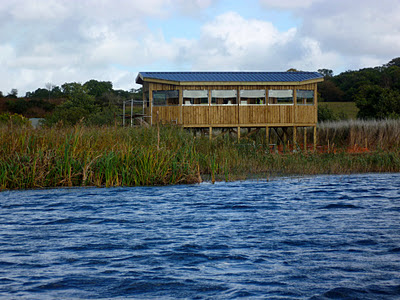Top two - Wallasea present. Lower two - Wallasea future? (Tiengemeten)
A trip out to Wallasea Island in Essex this week reminded me of a visit to The Netherlands earlier this year. The Wallasea Island ‘Wild Coast project’ is a landmark conservation and engineering scheme for the 21st century, on a scale never before attempted in the UK. The aim of this project is to combat the threats from climate change and coastal flooding by recreating the ancient wetland landscape of mudflats and saltmarsh, lagoons and pasture. It will also help to compensate for the loss of such tidal habitats elsewhere in England.
Although the Wallasea project may be the largest of its kind in this country, the Dutch are ahead of us in this sort of restoration. In the summer, I visited the island of Tiengemeten in South Holland and had a glimpse of what Wallasea may come to look like in the future. The project at Tiengemeten was undertaken as part of a programme to restore 3,000 ha of tidal areas in the Dutch Delta region, itself part of the wider Dutch Ecological Networks Plan to create 160,000 ha of ecological networks. Tiengemeten extends to 1,000 ha and was formed as agricultural land claimed from saltmarsh. Now it is being returned to near-naturally functioning habitat. The island has been divided into three zones. The Wilderness zone covers 700 ha and is ex-arable land now open to the influence of the tides and water regimes of the island. The Richness zone (250 ha) is a landformed area of shallow flooding, reedbed and scrub, wet in winter, drier in summer. Finally, the Cultural zone (50 ha) is made up of a campsite, a cafe and a few houses and cropped fields. Grazing by Highland cattle is the primary management tool.
The island was officially given back to nature in 2007 after it was purchased by the Dutch Government. In 2008, a full breeding bird survey was undertaken. The results included the following totals (pairs): 87 Bluethroat, 125 Avocets, 4 Black-winged Stilts, 151 Marsh Warblers, 18 Black-tailed Godwits, 11 Garganey, 3 Spotted Crakes, 3 Goshawk, 1 Corncrake and 612 Greylag Geese. Another full survey was undertaken this year and the results are awaited with interest.
Meanwhile, back on Wallasea, the landscape is still of arable fields surrounded by sea walls, and it has a way to go to match Tiengemeten. Despite this, the birding provided some anticipation. Thousands of Brent Geese and Lapwings fed in the fields. Hen Harrier, Marsh Harrier, Merlin and Peregrine hunted around the sea walls or over the areas of un-harvested crops retained to provide food for farmland birds. A single Rough-legged Buzzard and a Spoonbill provided the highlights for the day.



















































